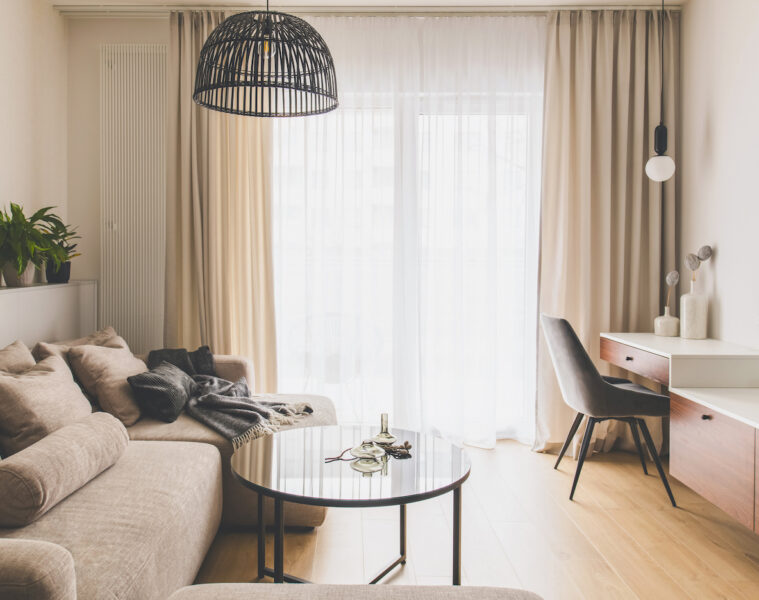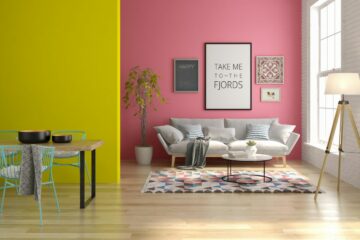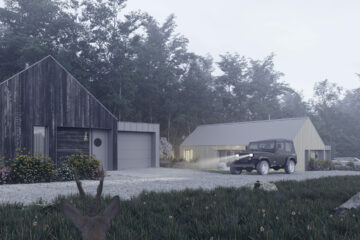Floor panels are a popular solution for enjoying a beautiful, durable floor surface. Modern models come in many patterns and shades, they are very accessible and installation is not a problem even for the untrained do-it-yourselfer. All this makes it an excellent option for refreshing the look of your home. What exactly are floor panels and when is it worth choosing them? What types of laminate can be purchased and how to care for them? We answer!
Floor panels – what are they?
Floor panels have been a solution since the end of the 1970s. Initially they were known as ‘laminate flooring’, which perfectly reflects the characteristics of this floor covering. This is because they are boards covered with impregnating varnishes of different hardnesses, which additionally have different patterns and finishes. They most often resemble natural wood, but can also imitate stone, tiles or textiles
Floor panels – what types are there?

Woodpanels
Manufacturers offer many different types of panels. Among the most popular models are the wooden ones. Underneath a layer of impregnating oil or varnish, there is a veneer (in other words a very thin plank) made of wood. Underneath this, there is a backing layer and a counter layer. Such panels can be made of high-grade, homogeneous selected wood as well as strongly grained raw material. Three-layer wood planks are a very durable and damage-resistant floor covering, as a special processing technology increases its strength
Laminatepanels
Laminated panels are created from compressed core paper and a paper covering that gives the panel its pattern. The decorative paper is placed on the wood-like core board. The most popular motif for this type of panel is classic wood
Vinyl panels
Vinyl panels are often associated with bland, grey tiles. Quite wrongly! Today’s vinyl panels are often reinforced with glass fibres, in addition to a core support layer and a backing layer, which make up the decorative coating. Vinyl panels can take on particularly beautiful motifs – imitating wood or natural stones, or resembling ceramic tiles, mosaics and patchworks

Cork panels
Cork is a material that comes entirely from nature. It is valued for its warmth, flexibility, durability, water resistance and sound insulating abilities. Floor panels of this type are based on a board core to which the actual cork layer is glued. Cork as a decorative layer is also used in panels with a vinyl base
Floor panels for special applications
Every user has his or her own individual flooring requirements. In one, durability and water resistance will be key, in another on hardness or sound insulation. By choosing flooring panels, each of these needs can be taken care of
Panels for high humidity
Vinyl panels, cork panels and those made from specially sealed HDF boards will work well in rooms with high humidity. Cork panels have the added benefit of providing excellent footfall dampening. This is due to their porous structure, which dampens any noise
Panels for homes with pets
If you have pets in the house, it is definitely worth paying attention to the abrasion class of the panel coatings and the matt finish of the panels. Those marked AC5 will be best, as they have the highest durability. This is particularly important as pets often bring sand into the home, which abrades the floor surfaces. In addition, it is worth taking an interest in panels with a high anti-slip rating – this will improve safety for pets

Panels for underfloor heating
Interestingly, panels of any type can be successfully laid in houses with underfloor heating. However, it is worth paying attention to the manufacturer’s recommendations for use with specific types of heating when purchasing. It is also necessary to ascertain how such panels are to be laid – using the appropriate adhesives or with a click. When choosing floorboards for underfloor heating, it is advisable to opt for those with a lower degree of thermal insulation – vinyl or laminate, with a low thickness
Floor panels – maintenance and care
A common problem associated with the use of laminate flooring is tarnishing. However, dealing with this problem is not a major challenge. Matt floor panels only need to be thoroughly cleaned of dust and then treated with a steam mop. This is both gentle on the surface and effective in removing dirt. Afterwards, it is advisable to clean the floor with water and a cleaner dedicated to the panels. However, remember to clean the panels lengthwise, not crosswise
Partner material




























